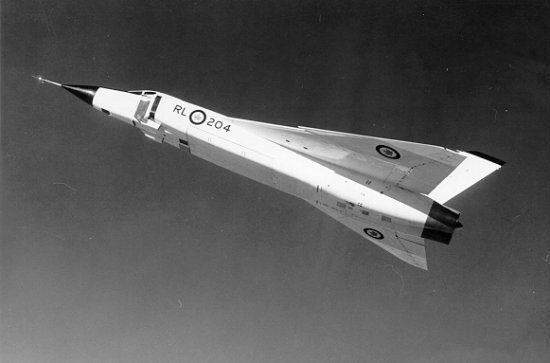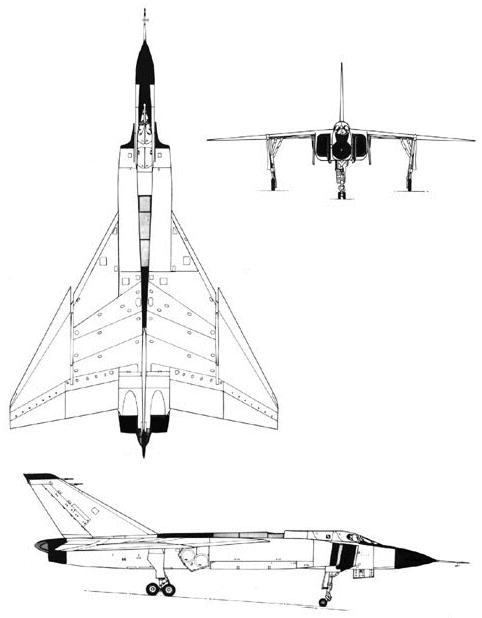|
||||||||||
|
|
||||||||||
|
||||||||||
|
|
||||||||||
 - -
|
|

|
Avro Canada CF-105 Arrow Interceptor |
|
DESCRIPTION:
The CF-105 Arrow was designed to meet a Royal Canadian Air Force (RCAF) requirement for a high-speed, high-altitude interceptor to compliment the CF-100. The Arrow that finally emerged was a remarkably advanced and sophisticated fighter. The design featured a high-mounted delta wing and a thin fuselage containing two powerful turbojets and an internal weapons bay. It was hoped that the CF-105 could achieve Mach 2.5, although the rapid evolution of engine technology during the 1950s and 1960s indicated that Mach 3 would be possible in the future. By April 1954, Avro Canada had already begun the manufacture of five Arrow Mk.1 prototypes powered by US Pratt & Whitney turbojets. Production Arrow Mk.2 models were to be equipped with Canadian-built Iroquois turbojets producing an additional 4,500 lb (20 kN) of thrust each. Though the Arrow development program was on course to producing a truly remarkable aircraft, the entire project was cancelled on 20 February 1959 because politicians felt that manned aircraft were soon to be made obsolete by surface-to-air missiles. The program's escalating costs likely also played a significant role in cancellation of the CF-105. As if to ensure that no future government would counteract the desicion, all five Arrow Mk.1s, one completed Arrow Mk.2 and four Arrow Mk.2s under construction were ordered to be detroyed. The cancellation forced Avro Canada to lay off over 80% of its work force and decimated other subcontractors throughout Canada. It is estimated that approximately 50,000 jobs were lost when the Arrow program ended, and the Canadian aerospace industry was never able to recover.
Last modified 07 October 2010
|
|
| HISTORY: | |
| First Flight | 25 March 1958 |
|
Service Entry
|
did not enter service
|
|
CREW:
|
two: pilot, radar operator
|
|
ESTIMATED COST:
|
unknown
|
| AIRFOIL SECTIONS: | |
| Wing Root | NACA 0003.5 mod |
| Wing Tip |
NACA 0003.8 mod
|
| DIMENSIONS: | |
| Length | 77.81 ft (23.715 m) |
| Wingspan | 50.00 ft (15.24 m) |
| Height | 21.25 ft (6.477 m) |
| Wing Area | 1,225 ft² (113.8 m²) |
|
Canard Area
|
not applicable
|
| WEIGHTS: | |
| Empty | 49,040 lb (22,245 kg) |
| Normal Takeoff | 57,000 lb (25,855 kg) |
| Max Takeoff | 62,430 lb (28,315 kg) |
| Fuel Capacity |
internal: 2,900 gal (13,170 L) external: 500 gal (2,275 L) |
|
Max Payload
|
unknown
|
| PROPULSION: | |
| Powerplant |
(Arrow Mk.1) two Pratt & Whitney J75-3/5 afterburning turbojets (Arrow Mk.2) two Orenda PS-13 Iroquois afteburning turbojets |
| Thrust |
(Arrow Mk.1) 47,000 lb (209.1 kN) (Arrow Mk.2) 56,000 lb (249.1 kN) |
| PERFORMANCE: | |
| Max Level Speed |
at altitude: Mach 2.5 [Arrow Mk.2] Mach 2.2 [Arrow Mk.1] at sea level: unknown |
| Initial Climb Rate | unknown |
| Service Ceiling | 58,500 ft (17,850 m) |
| Range |
typical: unknown ferry: unknown |
| g-Limits |
unknown
|
| ARMAMENT: | |
| Gun | none (?) |
| Stations | one internal weapons bay |
| Air-to-Air Missile | 8 Sparrow AAM |
| Air-to-Surface Missile | none |
| Bomb | none |
| Other |
none
|
| KNOWN VARIANTS: | |
| Arrow Mk.1 | Prototype; 5 built |
| Arrow Mk.2 |
Production model with a new engine; only 1 completed before project cancellation
|
|
KNOWN COMBAT RECORD:
|
none
|
|
KNOWN OPERATORS:
|
Canada (Royal Canadian Air Force) |
|
3-VIEW SCHEMATIC:

|
|
SOURCES:
|
|


|
Aircraft | Design | Ask Us | Shop | Search |

|
|
| About Us | Contact Us | Copyright © 1997-2023 | |||
|
|
|||